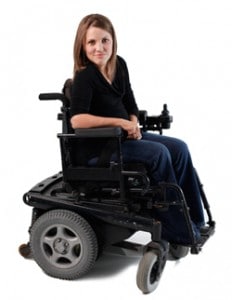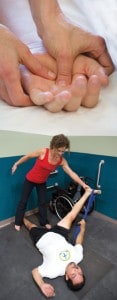

In 2005, Chanda Hinton Leichtle started The Chanda Plan Foundation, hoping to offer acupuncture, massage, chiropractic care and adaptive yoga to people with disabilities. Having experienced the benefits of these integrative therapies, her initial dream was to offer funding for those who can’t afford or lacked insurance coverage for the alternative integrative therapies.
The Chanda Plan Foundation now has a facility with 129 active participants. The Foundation also funds integrative therapies, offering some of them on site. More importantly, in 2009, Hinton Leichtle, now executive director for the Foundation, proposed a bill to her Colorado state legislature, which passed, mandating a three-year Medicaid pilot program to pay for 67 Medicaid recipients with SCI. Now in its first year, the pilot program ends in 2015, at which time Hinton Leichtle and a representative of Colorado Healthcare Policy and Financing will present its findings on improved participant quality of life and cost savings with the hopes that it will become a Medicaid benefit for all recipients in Colorado.
“We want to show that these modalities can save our state a lot of money, because if we are being proactive and preventative with the secondary conditions that come with SCI, we are going to have fewer emergency room visits, 911 calls, procedures and major tests,” says Hinton Leichtle. “We’re going to show that we can eliminate all of these ongoing expenses because we’re maintaining wellness in the body of someone with an SCI [or other disability] by giving them massage, acupuncture and chiropractic care.”
But mostly, Hinton Leichtle, who sustained a C5-6 SCI at the age of 9, wants all people with disabilities to feel the benefits of integrative therapies.
At 19, weighing only 59 pounds, years of secondary conditions resulting from SCI put her in the hospital on a feeding tube. Afterward, she started doing integrative therapies to relieve pain, and she credits those therapies with saving her life.
“While an injury [or other disability] is the primary condition, it’s essential to take notice of secondary conditions such as autonomic dysreflexia, bowel/bladder dysfunction, pain, osteoarthritis, muscle atrophy, depression, etc.,” explains Hinton Leichtle. “Be open to preventative measures, so that your wellness and disability can co-exist.”
Chanda’s Plan for a Healthier Body
• Drink water: Not only can it help prevent urinary tract infections, it can be helpful for blood circulation and prevention of blood clots. Take a few extra minutes in the shower to run hot water and soak. The steam helps to loosen muscles and nasal passages, improving breathing, which helps with oxygen flow and blood circulation.

• Eat cruciferously: Everyone knows that bones need calcium and weight bearing to maintain bone density, but when bearing weight is not an option, kale and other green leafy vegetables are a great source of calcium to help increase bone density.
• Move it: Movement is life, and when all movement stops, secondary conditions become worse. If you cannot afford therapy or yoga, create a routine with a friend or family member to help you with range of motion. It not only reduces spasticity and joint stiffness, it can help your endocrine system secrete hormones directly into the bloodstream, affecting your sleep, mood, etc.
• Eat healthy: Honor your body by eating well. Don’t just shove junk food into your mouth. Remember that before your disability, your bowels, bladder and everything that used to function were not problems. Food and nutrition is only going to help integrative therapies do what they need to do to the body.
• Acupuncture: If chronic pain is your major complaint, Hinton Leichtle typically suggests acupuncture because it’s a restorative, nonaggressive, gentle therapy to get you out of chronic pain. As soon as you address pain, other symptoms such as UTI, muscle atrophy or joint stiffness start to pop up, like peeling away the layers of an onion.
• Massage, exercise or yoga: For those with CP, MD or other conditions, where you have little or no movement, stiffness and spasticity, maybe it’s not chronic pain that derives from nerve or organ dysfunction, but pain in your lower back or upper shoulder caused by having a really strong spastic arm. The more you can massage the muscles, loosen them and do range of motion with your arm, the better. But sometimes when muscles or tendons are very tight, it can be more violent or painful, more damaging, when you do something dramatic to the body without loosening it up first.
“Water, proper food and movement can make all the difference in living healthy with a disability,” says Hinton Leichtle. “Be patient. The longer you’ve been disabled, the longer your body will take to respond to new choices. And remember that when one symptom is relieved, another one can surface. Trust your body … be open to what your primary symptoms are, then look at all the integrative therapies and what are their best benefits.”
For more on The Chanda Plan Foundation, visit www.thechandaplanfoundation.org.
Support New MobilityWait! Before you wander off to other parts of the internet, please consider supporting New Mobility. For more than three decades, New Mobility has published groundbreaking content for active wheelchair users. We share practical advice from wheelchair users across the country, review life-changing technology and demand equity in healthcare, travel and all facets of life. But none of this is cheap, easy or profitable. Your support helps us give wheelchair users the resources to build a fulfilling life. |


Recent Comments
Bill on LapStacker Relaunches Wheelchair Carrying System
Phillip Gossett on Functional Fitness: How To Make Your Transfers Easier
Kevin Hoy on TiLite Releases Its First Carbon Fiber Wheelchair